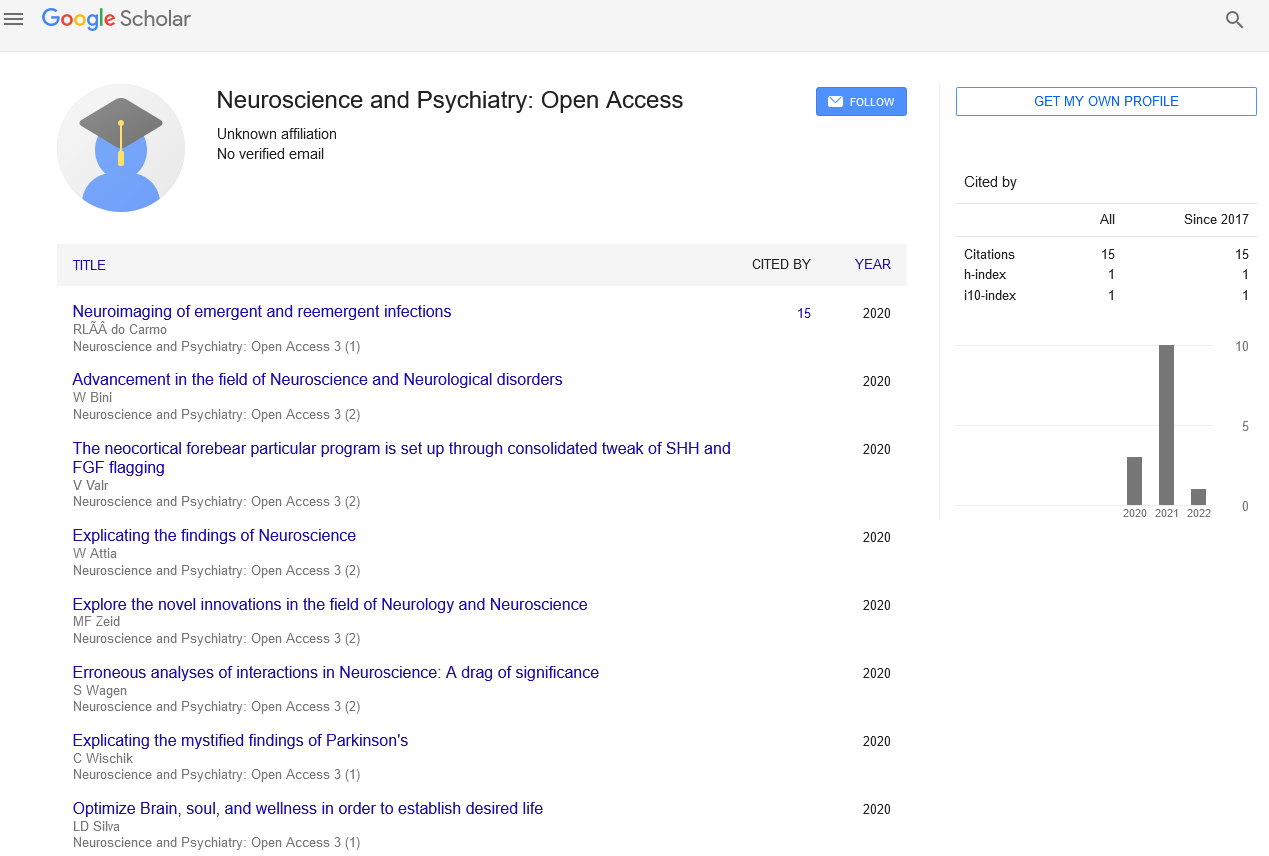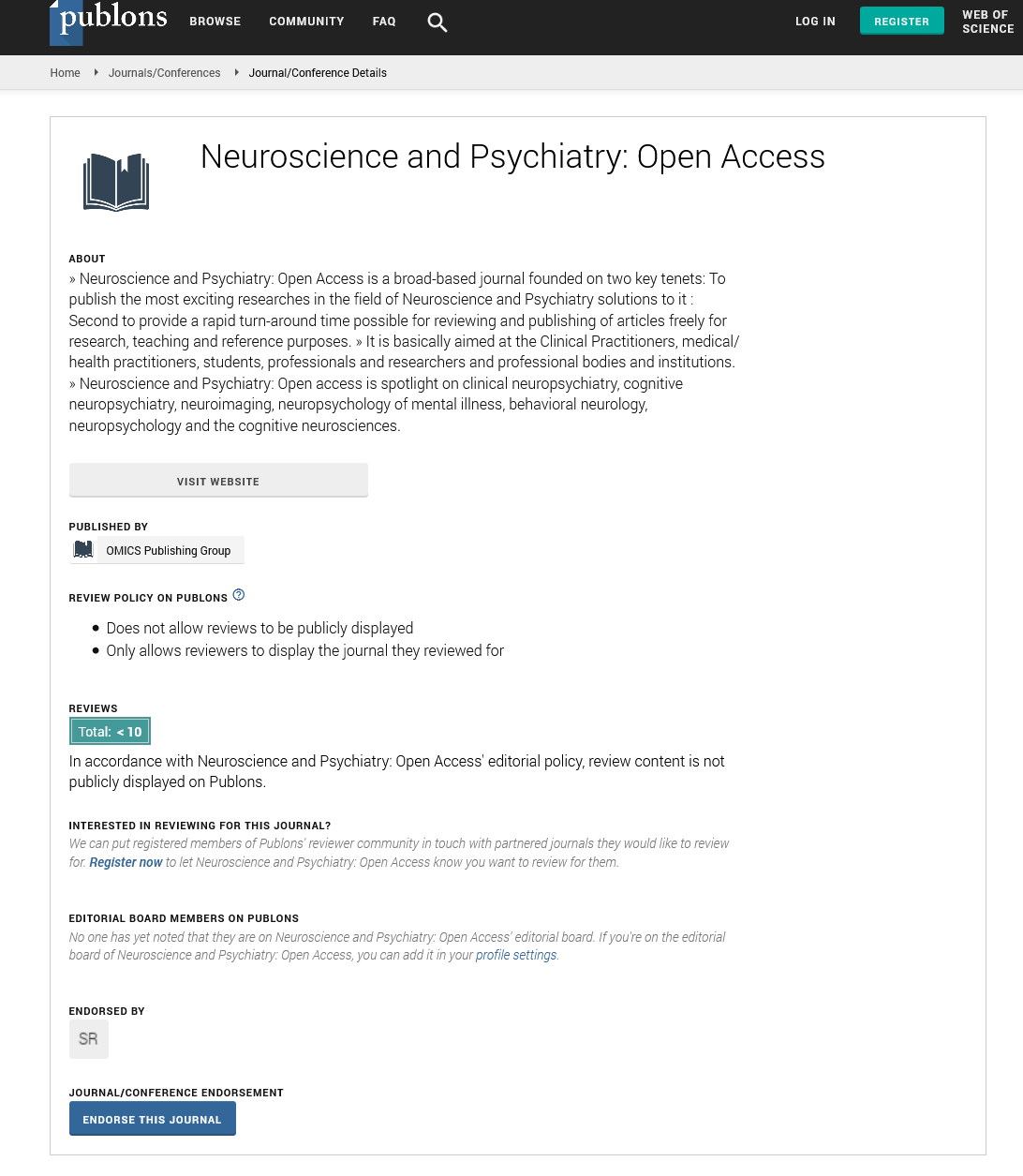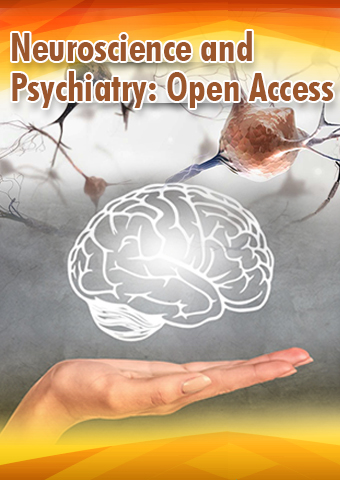Editorial - Neuroscience and Psychiatry: Open Access (2023) Volume 6, Issue 4
Neuroplasticity's Power: Unleashing the Brain's Adaptive Potential
Marina Carias*
College of Nursing, Department of Neuroscience University of Brazil
*Corresponding Author:
College of Nursing, Department of Neuroscience University of Brazil
E-mail: marina@gmail.com
Received: 01-08-2023, Manuscript No. npoa-23-109715; Editor assigned: 04-08-2023, Pre QC No. npoa-23- 109715; Reviewed: 18-08-2023, QC No. npoa-23-109715; Revised: 25-08-2023, Manuscript No. npoa-23- 109715 (R); Published: 31-08-2023, DOI: 10.37532/npoa.2023.6(4).80-82
Abstract
Our understanding of the brain's capacities has been completely transformed by neuroplasticity, the brain's amazing capacity to adapt and reorganise itself. The conventional wisdom that the brain's form and function are fixed after a crucial developmental stage is called into question by this event. Synaptic plasticity, structural modifications, and functional reorganisation are just a few of the techniques referred to as neuroplasticity that the brain uses to adjust its connections and perform at its best. The influence of neuroplasticity on learning, recovery, and mental health is examined in this article. It analyses how neuroplasticity affects learning and memory formation and discusses the mechanisms underpinning neuroplasticity, including as synaptic strengthening and the creation of new neurons. It also examines the critical role neuroplasticity plays in rehabilitation. The essay also discusses how neuroplasticity and mental health are interconnected, highlighting how unhelpful plasticity may be a factor in psychiatric disorders and how therapeutic approaches can use neuroplasticity to aid in healing and wellbeing. It concludes by examining methods and lifestyle elements that promote neuroplasticity and highlighting the significance of physical activity, mental stimulation, and a healthy lifestyle for enhancing brain health. The adaptive capacity of the brain can be unlocked by comprehending and utilising neuroplasticity, opening the door for novel educational, therapeutic, and mental health interventions.
Keywords
Neuroplasticity • Brain plasticity • Adaptive potential • Synaptic plasticity • Structural plasticity • Functional reorganization • Learning • Memory • Rehabilitation • Brain injuries • Mental health • Psychiatric disorders • Recovery • Well-being • Synapses • Neuronal connections • Neural rewiring • Cognitive abilities • Resilience • Optimal brain health
Introduction
With its complex network of billions of neurons, the human brain has long fascinated scientists and researchers. For many years, it was thought that the structure and function of the brain were fixed, rigid, and did not change after a crucial stage of development [1]. These long-held ideas, however, have been disproved by recent advancements in the field of neuroscience, which also revealed the amazing phenomenon known as neuroplasticity [2]. The brain's remarkable capacity to adjust, reorganise, and remodel itself in response to experiences, learning, and environmental changes is known as neuroplasticity, also known as brain plasticity [3]. It challenges the idea that the brain is fixed in nature and represents a significant shift in our knowledge of its possibilities [4]. The potentialities offered by neuroplasticity suggest that our brains have unrealized growth potential. Neuroplasticity primarily entails modifications to the brain's connections, structure, and functionality [5]. It includes the development of new neurons, the destruction of old synapses, and the rebuilding of brain networks. These dynamic processes take place not only in the early stages of development but even as adults, enabling the brain to adjust to new situations, learn new abilities, and heal from wounds [6]. Neuroplasticity is underpinned by a variety of complex mechanisms. Learning and memory formation depend heavily on synaptic plasticity, the ability of synapses to strengthen or weaken their connections [7]. Physical alterations in the brain, such as the development of additional dendritic branches or synapses, are examples of structural plasticity. These alterations result in long-term modifications in neural connection. Learning about neuroplasticity has significant ramifications for a variety of fields, such as education, rehabilitation, and mental health [8]. In addition to providing a scientific foundation for lifelong learning, brain injury healing, and therapeutic approaches for psychiatric diseases, it challenges conventional ideas of fixed talents. We can open up new doors for development, resiliency, and wellbeing by maximising the brain's capacity for adaptation. In this essay, we explore the mechanisms, uses, and consequences of the interesting field of neuroplasticity [9]. We'll look at how neuroplasticity affects memory and learning, how it helps people recover from brain injuries, and how it relates to psychiatric and mental health issues. We'll also look into lifestyle choices and methods that help improve neuroplasticity and advance good mental health. The extraordinary phenomenon of neuroplasticity, commonly referred to as brain plasticity, challenges our knowledge of the capabilities of the brain [10]. After a particular crucial stage of development, it was once thought that the brain's structure and function were set in stone. But ground-breaking neuroscience research has revealed that the brain has a remarkable capacity for self-organization and adaptation over the course of a lifetime. In this article, the notion of neuroplasticity, its underlying mechanisms, and its consequences for education, therapy, and mental health are all explored.
Mechanisms of neuroplasticity: Neuroplasticity is mediated by a number of processes, such as synaptic plasticity, structural plasticity, and functional reorganisation. Modifications to the effectiveness and strength of neuronal communication are a result of synaptic plasticity. It is mediated by processes that are essential for learning and memory formation, including as long-term potentiation (LTP) and long-term depression (LTD). A change in the physical makeup of the brain, such as the development of new dendritic branches or synapses, is referred to as structural plasticity. When the brain redistributes its functions to other regions in response to damage or learning, functional reorganisation takes place.
Learning and neuroplasticity: Learning and memory are directly related to neuroplasticity. Synaptic connections are strengthened or decreased as a result of learning new information or abilities, which helps create new brain pathways. We can gain knowledge, adjust to new settings, and hone our motor skills thanks to this process. The brain's neural networks get more honed and optimised as we participate in challenging events and learning-related activities. The biological basis for lifelong learning is provided by neuroplasticity, which also creates intriguing new opportunities for educational interventions.
Neuroplasticity and Mental Health: The idea of neuroplasticity has important ramifications for psychiatric diseases and mental wellness as well. Maladaptive neuroplasticity may play a role in the emergence and maintenance of mental illnesses like addiction, anxiety, and depression. But there is also potential for therapeutic approaches because of the plasticity of the brain. Positive alterations in neural circuits can be induced through psychotherapy, cognitive-behavioral therapy, and mindfulness exercises, rewiring the brain to produce healthier thought and behaviour patterns. Additionally, pharmaceutical therapies can influence neuroplasticity, encouraging neurogenesis and synaptic connection in people with psychiatric disorders.
Conclusion
It is truly amazing how much the brain can change and adapt thanks to neuroplasticity. The finding that the brain has a remarkable capacity to adapt and reorganise itself throughout the course of life has forever altered our understanding of its potential. The long-held notion that the brain's structure and function are set in stone is challenged by neuroplasticity, which creates a wealth of opportunities for development, learning, healing, and overall wellbeing. Neuroplasticity enables the brain to adapt to new experiences, learn new abilities, and recover from traumas through the complex processes of synaptic plasticity, structural alterations, and functional reorganisation. The brain's ability to adapt is influenced by the creation and destruction of synapses, the growth of new neurons, and the rewiring of neural circuits. These processes shape the brain throughout adulthood and are not just limited to early development, offering several opportunities for development and improvement. The ramifications of neuroplasticity are broad and have significant effects on learning, recovery, and mental health. We can use neuroplasticity to improve learning and memory formation by grasping the mechanisms underlying it. By creating tactics that take advantage of the brain's adaptability, educators may create environments that are ideal for learning and support lifelong learning. Neuroplasticity offers opportunities and hope for people healing from brain injuries in the field of rehabilitation. Undamaged parts of the brain can take up the functions of damaged parts through functional reorganisation, facilitating rehabilitation and the relearning of crucial abilities. Neuroplasticity-based rehabilitation programmes can speed up these procedures and improve patients' functional outcomes.
References
- Davidson RJ, McEwen BS. Social influences on neuroplasticity: stress and interventions to promote well-being. Nat Neurosci. 15,689-695 (2012).
- Park DC, Huang CM. Culture Wires the Brain: A Cognitive Neuroscience Perspective. Perspect Psychol Sci. 5, 391-400 (2010).
- McEwen BS. Redefining neuroendocrinology: Epigenetics of brain-body communication over the life course. Front Neuroendocrinol. 49, 8-30 (2018).
- Leuner B, Gould E. Structural plasticity and hippocampal function. Annu Rev Psychol. 61, 111-140 (2010).
- Ganguly K, Poo MM. Activity-dependent neural plasticity from bench to bedside. Neuron. 80, 729-741 (2013).
- Zaidel, Dahlia W. Art and brain: insights from neuropsychology, biology and evolution. Journal of Anatomy. 216, 177-183 (2010).
- Tramontin AD, Brenowitz EA. Seasonal plasticity in the adult brain. Trends Neurosci. 23,251-8 (2000).
- Smith GT. Seasonal plasticity in the song nuclei of wild rufous-sided towhees. Brain Research. 734, 79-85 (1996).
- Hofman MA, Swaab DF. Seasonal changes in the suprachiasmatic nucleus of man. Neurosci Lett. 139,257-260 (1992).
- Mundkur N. Neuroplasticity in children. Indian J Pediatr. 72,855-857 (2005).
Indexed at, Google Scholar, Crossref
Indexed at, Google Scholar, Crossref
Indexed at, Google Scholar, Crossref
Indexed at, Google Scholar, Crossref
Indexed at, Google Scholar, Crossref
Indexed at, Google Scholar, Crossref
Indexed at, Google Scholar, Crossref
Indexed at, Google Scholar, Crossref
Indexed at, Google Scholar, Crossref


